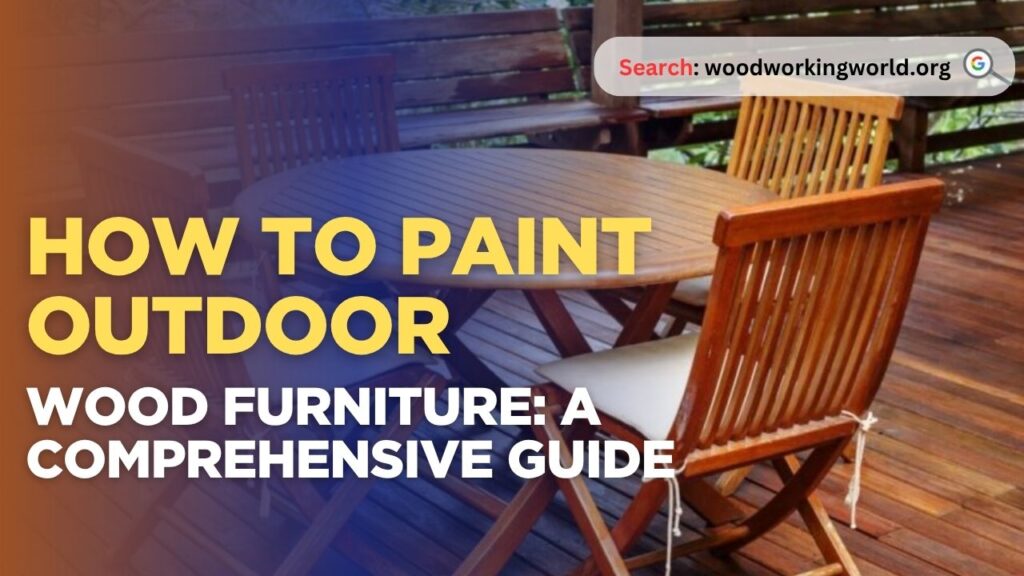How to Paint Outdoor Wood Furniture: A Comprehensive Guide
Struggling with faded, peeling, or weather-damaged outdoor furniture? Painting outdoor wood pieces is one of the easiest ways to revive their look, protect them from the elements, and extend their lifespan—but only if you use the right prep steps, tools, and paint. So how do you ensure a smooth, long-lasting finish that can withstand sun, rain, and daily use?
In this comprehensive guide to painting outdoor wood furniture, we’ll cover the best preparation techniques, the most durable paint types, essential tools, step-by-step instructions, finishing tips, and most importantly—how to achieve a professional, weather-resistant result that keeps your furniture looking great season after season.

👉 CLICK HERE to Unlock 16,000+ DIY woodworking plans now
How to Paint Outdoor Wood Furniture
Materials You’ll Need
Before you start, gather the following materials:
- Outdoor wood furniture
- Sandpaper (80-grit and 220-grit)
- Scraper or putty knife
- Wood filler
- Paint stripper (if necessary)
- Drop cloths or tarps
- Painter’s tape
- Brushes or paint sprayer
- Primer (oil-based or latex)
- Exterior paint (oil-based or latex)
- Clear sealer (optional)
- Safety gear (gloves, mask, goggles)
Step-by-Step Guide on How to Paint Outdoor Wood Furniture
1. Prepare Your Workspace
Choose a well-ventilated area, preferably outdoors or in a garage with good airflow. Lay down drop cloths or tarps to protect the ground and surrounding areas from paint and debris. Ensure you have all your materials within reach.
2. Clean the Furniture
Start by cleaning your furniture thoroughly. Use a mixture of mild detergent and water to remove dirt, grime, and mildew. Scrub the surface with a brush or sponge, then rinse with clean water. Allow the furniture to dry completely before moving on to the next step.
3. Remove Old Paint or Finish
If your furniture has old paint or a finish that’s peeling or chipping, you’ll need to remove it. Use a paint stripper according to the manufacturer’s instructions, or sand the surface with 80-grit sandpaper to remove the old layers. For intricate details, use a scraper or putty knife to gently remove paint.
👉 CLICK HERE to Unlock 16,000+ DIY woodworking plans now
4. Sand the Surface
Once the old paint or finish is removed, sand the entire surface with 220-grit sandpaper. This will smooth out any rough spots and create a good surface for the primer to adhere to. Be sure to sand in the direction of the wood grain to avoid scratches.
5. Repair Any Damage
Inspect your furniture for any cracks, holes, or other damage. Use wood filler to repair these areas, following the product instructions. Once the filler is dry, sand the repaired spots until they are smooth and level with the rest of the surface.
6. Prime the Furniture
Applying a primer is essential for outdoor furniture, as it helps the paint adhere better and provides a barrier against moisture. Choose a primer that is suitable for outdoor use and compatible with the type of paint you plan to use (oil-based or latex).
- Oil-based primer: Offers excellent adhesion and durability, ideal for outdoor conditions.
- Latex primer: Easier to clean up and less toxic, suitable for less extreme outdoor environments.
Apply the primer with a brush or paint sprayer, following the wood grain. Allow it to dry according to the manufacturer’s instructions. Typically, this takes about 24 hours.


7. Sand Again
After the primer has dried, lightly sand the surface with 220-grit sandpaper. This step ensures a smooth finish and helps the paint adhere better. Wipe away any dust with a clean, damp cloth.
8. Apply the Paint
Now it’s time to paint your furniture. Choose a high-quality exterior paint that can withstand the elements. Both oil-based and latex paints can be used, but latex paint is often preferred for its ease of use and cleanup.
- Oil-based paint: Durable and resistant to moisture, but takes longer to dry and requires mineral spirits for cleanup.
- Latex paint: Dries quickly, easy to clean up with water, and less toxic, but may not be as durable as oil-based options.
Apply the paint with a brush or paint sprayer, following the wood grain. For best results, apply multiple thin coats rather than one thick coat. Allow each coat to dry completely before applying the next one. This usually takes about 4-6 hours, but check the paint can for specific drying times.
9. Seal the Paint (Optional)
For added protection, especially if your furniture will be exposed to harsh weather, consider applying a clear sealer. This can help protect the paint and extend the life of your furniture. Choose a sealer that is compatible with your paint type and apply it according to the manufacturer’s instructions.
10. Let It Cure
Allow the paint (and sealer, if used) to cure fully before using your furniture. This process can take several days to a week, depending on the weather and the type of paint used. Avoid exposing the furniture to heavy use or harsh conditions during this time.
Tips for Success
- Weather Considerations: Choose a day with mild weather for painting. Extreme temperatures, humidity, or wind can affect the drying process and the final result.
- Test the Paint: Before committing to a color, test the paint on a small, inconspicuous area of the furniture. This helps ensure you’re happy with the color and finish.
- Brush Quality: Invest in high-quality brushes or a paint sprayer for a smooth, even finish. Cheap brushes can leave streaks and bristles behind.
- Maintenance: Regularly clean and inspect your painted furniture to keep it looking its best. Touch up any chipped or worn areas promptly to prevent further damage.
Common Mistakes to Avoid
- Skipping Primer: Primer is crucial for outdoor furniture as it helps the paint adhere better and provides a barrier against moisture.
- Applying Thick Coats: Multiple thin coats are better than one thick coat. Thick coats can lead to drips, uneven coverage, and longer drying times.
- Ignoring Weather Conditions: Painting in extreme weather conditions can cause the paint to dry too quickly or too slowly, leading to a poor finish.
- Using the Wrong Paint: Ensure you use paint that is specifically designed for outdoor use. Indoor paint won’t withstand the elements and will deteriorate quickly.
👉 CLICK HERE to Unlock 16,000+ DIY woodworking plans now
Conclusion: How to Paint Outdoor Wood Furniture
How to Paint Outdoor Wood Furniture: Painting outdoor wood furniture is a rewarding DIY project that can dramatically improve the look of your outdoor space. By following these steps and taking the time to do the job right, you can ensure a beautiful, durable finish that will last for years. Remember to choose the right materials, prepare the surface properly, and apply the paint with care. Happy painting!
I hope this article on How to Paint Outdoor Wood Furniture has been helpful. If you have any further questions, please feel free to leave a comment below.
👉 CLICK HERE to Unlock 16,000+ DIY woodworking plans now
